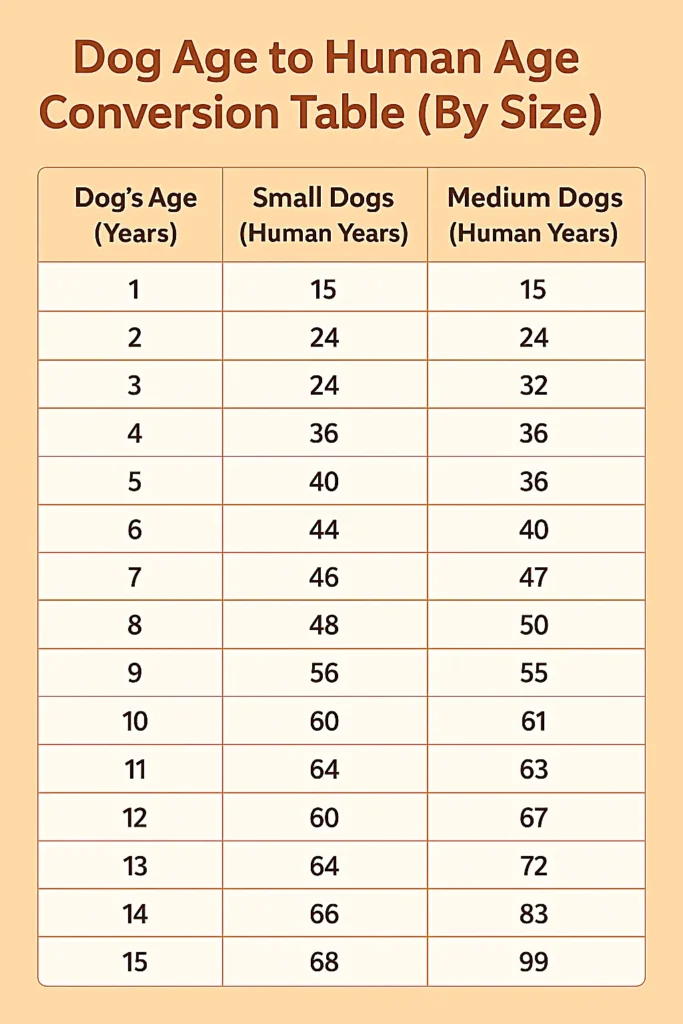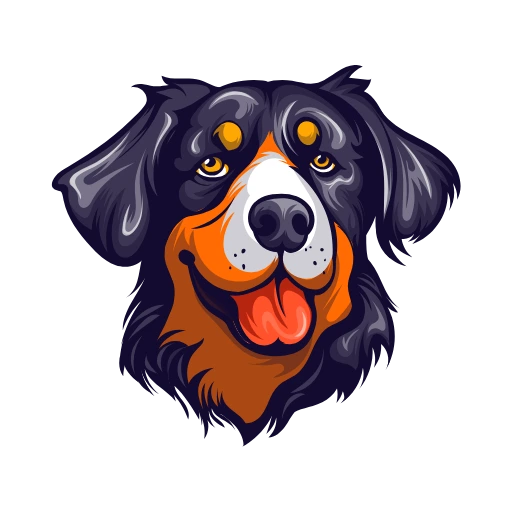Dog Age Calculator
Discover your dog's human age using advanced DNA methylation science
Your dog is equivalent to
Scientific Accuracy
This calculator uses the latest DNA methylation research published in Cell Systems (2020).
The formula 16 × ln(dog age) + 31 provides a more accurate representation than the old "multiply by 7" rule,
taking into account the fact that dogs age much faster during their first two years of life, then more slowly thereafter.
Breed size adjustments are based on extensive veterinary lifespan studies.
Dog years to Human years
Many people think that a dog’s 1 year equals 7 human years, but in reality, this formula doesn’t apply to every dog. Every breed, size, and growth rate is different, which directly affects a dog’s real age. People often estimate their dog’s real age and health needs incorrectly. This confusion creates many problems in the health planning of a dog.
But don’t worry, all of your confusion is about to end. We’ll tell you the real scientific method, which allows you to calculate dog years to human years. In this article, we will break down the development stages of dogs and also provide a chart that will help you convert dog years to human years. You can use our Dog Age Calculator, which is based on the advanced DNA Methylation Science.
Why Understanding Dog Years Matters
Many people falsely understand their dog’s real age and just apply the one dog year = seven human years formula. This outdated formula is not accurate for every breed, size, and growth pattern. Due to this confusion, dog owners do not care for their dog properly, such as with health care, exercise, etc. As a result, the aging process of the dog cannot be managed properly.
When you use the proper scientific method and size-based breed model, you can realistically estimate the stage your dog is going through, like puppyhood, adulthood, or the senior phase. This knowledge helps you to take care of your dog and to provide emotional support as it goes through its age stages. Research like UCSD’s epigenetic study proves that with the help of DNA Methylation, we can predict the accurate biological age of a dog.
The Common Myth: One Dog Year Equals Seven Human Years
For many years, people believed that one dog year equals seven human years. This formula is simple, but it is inaccurate. Due to this myth, many dog owner measure the incorrect age of their dog and do not take care of them as they should. A small breed dog can be active for 16 years, whereas a dog of a large breed enters the senior stage at the age of 8.
Science proved that the dog years to human years rate totally depends upon the size, breed, and genetics. Now, size-based models and stage-based models are becoming more reliable in measuring the age of a dog.
How to Convert Human Years to Dog Years
Modern research revealed that a dog ages rapidly in the first year of its life. For example, a one-year-old dog is equivalent to a 30-year-old human, and after 7 years of its life, its growth rate becomes slow.
2019 Epigenetic Clock Study
Researchers at UC San Diego made an epigenetic clock with the help of DNA Methylation and created a formula for human years to dog years calculator. By this method, they aligned the developmental milestones of humans and dogs, which is better and more accurate than the old 1:7 formula.
Formula to calculate a dog’s age in human years
Human Age = 16 × ln(Dog’s Age) + 31
Here, “ln” refers to the natural logarithm. This is the more accurate biological formula to calculate the dog’s age in human years.
How Dog Years Compare to Human Years Based on Breed Size
The table to compare dog years to human years is given below:
| Dog’s Age | Small Breed (Under 20 lbs) | Medium Breed (21–50 lbs) | Large Breed (Over 50 lbs) | Human Equivalent | Life Stage |
| 1 year | 15 years | 15 years | 14 years | Teenager (14-15) | Puppyhood |
| 2 years | 24 years | 24 years | 22 years | Young Adult (22–24) | Adolescence |
| 3 years | 28 years | 28 years | 30 years | Adult (28–30) | Adulthood |
| 7 years | 44 years | 47 years | 55 years | Middle-Aged (44–55) | Senior |
How Do Researchers Come Up With Those Numbers?
Researchers do not make these numbers randomly; there is proper scientific research. Scientists study DNA Methylation patterns of dogs, which are basically biological markers of aging. By this method, they analyze the speed of the cell aging process, and then they convert dog years to human years.
Dog years to human years Conversion Table (By Size)
The conversion chart of dog years to human years is given below. You can read it and take care of your dog accordingly.

Life Stages of Dogs
Below are the different life stages of dogs, from baby to adulthood.

Baby
Dog Age: 0-2 weeks
Human Equivalent: 0-1 years
Characteristics: No teeth, ears closed, eyes closed, sleepy.

Puppyhood
Dog Age: 2 weeks to 6 months
Human Equivalent: 1-10 Years
Characteristics: Teething, learning stage, training phase

Adolescence
Dog Age: 6 months to 2 years
Human Equivalent: 10 to 25 years
Characteristics: Puberty, high energy, training phase

Adulthood
Dog Age: 2 to 6 years
Human Equivalent: 25-45 Years
Characteristics: Physically mature, less active
How Long Do Dogs Live?
Size, breed, genetics, and lifestyle are part of aging in dogs. The size of dogs is an important part of their lifecycle.
Size
The size and weight of a dog have a great impact on their age. The dogs that are smaller in size live longer than the dogs that are larger in size. Scientists are not entirely sure why smaller dogs live longer and grow slowly. But according to their experience, larger dogs grow rapidly, which increases the chances of the growth of an abnormal cell that causes cancer and other diseases. The lifespan of the small and medium-sized dogs is 10-15 years, and some breeds live almost 18 years. At the same time, dogs that are larger in size, like German shepherds, Golden retrievers, and Labrador retrievers, live around 8-12 years. You can find out your dog years to human years by using a dog age calculator.
Breed and Genetics
There are some breeds that have health issues in their genetics. Dogs inherit genes from their parents, which increases the rate of health issues that are present in their parents’ bodies. Certain breeds have health issues that affect the aging process of dogs. For example, pug dogs face breathing difficulties, and German Shepherds have hip dysplasia.
Lifestyle
The lifestyle of dogs is also an important part of their lives. Proper diet and care increase the rate of the dogs. People should keep their dogs physically fit. They need proper care for a healthy life because they are sensitive to health issues.
Why Age Conversion Varies by Breed and Size
Converting dog years to human years is not the same for every breed. Small Breed dogs like Chihuahua grow rapidly, but their aging process is slow, which is why they live a long life. Medium-sized dogs have a moderate growth and aging rate, which is why their dog years to human years conversion remains balanced.
But large and giant breeds like the German Shepherd and the Great Dane become old very quickly. Their metabolism is fast and their organ become weak very soon. Genetic factors and health issues accelerate their aging. Because of that, it is important to make a specific chart for a specific breed.
Why Do Smaller Dogs Live Longer than Larger Dogs
Small dogs live longer than large dogs because their growth and development are slow, and their metabolism also remains stable. When they are in their puppyhood, their small size results in minimal stress on their cells. It helps their organs to remain healthy, so the overall life expectancy of a dog is increased.
On the other hand, large dogs like the Great Dane and Labrador grow rapidly, but this speed puts more pressure on the organs and bones. As a result, the aging process becomes faster, and the risk of disease increases. Scientists revealed that the risk of cancer and heart problems in larger dogs is higher.
Signs of aging in Dogs
If you adopted a dog but you do not know the age of that dog, you can still guess the age of your dog. The dog’s teeth will give you a rough idea of how old your dog is. Here are some guidelines that will help you in suggesting the age of your dog
- In 8 weeks,The baby teeth are all in.
- In 7 months, The permanent teeth are white and clean.
- In 1-2 years, A Few back teeth are yellow and become dull.
- In 5-10 years, Teeth show the signs of diseases.
- In 10-15 years, Few teeth are missing, and heavy tartar buildup.
- In 18 years, Wisdom teeth start to grow and may feel tightness.
A vet can guess dog years to human years more accurately because he has knowledge of the growth of dogs. He will examine your dog physically and give you a rough guess. You should use a dog age calculator to identify the age. A few signs that a dog shows when he is reaching the senior stage:
How to help your dog live longer?
There are a few methods to help your dog live longer, which you should apply after identifying the age of your dog, using a dog age calculator:
Feeding them healthy food
Give your dog high-quality pet food because it contains different types of nutrients, which keep your dog healthy and fit. You should give them a diet according to their age. Never give your dog the remaining, oily food from home because it will affect their digestive system.
Regular Exercise and Mental Stimulation
A dog’s heart, muscles, and joints stay healthy if you give them daily exercise and physical activity. Your dog should be active. For this, we should keep them mentally healthy by providing them with games like puzzles and interactive games.
Keep their weight normal
You should talk to the vet about how much weight is normal for my dog. Then take proper care and give your dog exercise and a walk according to their weight. Proper care will help your dog stay healthy.
Routine Veterinary Check-ups
Visit with your dog to the vet after 6 months for a complete check-up. Vaccinate your dog and take care of parasite control. Early diagnosis treats small diseases and does not let them affect the whole body. These methods help to increase the lifespan of your dog.
Does a Dog’s Breed Affect Their Dog Years to Human Years Calculation?
Yes, a dog’s breed affects their dog years to human years calculation. Every breed has a different genetic makeup; due to this, their growth rate, aging speed, and health risks are different from each other. For example, small breeds like Chihuahuas and Toy Poodles age slowly, whereas large breeds like Great Danes and Mastiffs age more quickly.
Some breeds are naturally healthy, and the chance of genetic disease in them is low. Due to this, their lifespan is long, and they are counted “younger” in human years. On the other hand, some breeds have joint problems, heart disease, and higher cancer risks, which accelerate their aging. So it’s not only about the size, but breed is also one of the main factors.
Did you know?
It is quite interesting that the concept of comparing dog years to human years dates back centuries. In 1268, a prediction about the judgement day was written on the Cosmati Pavement at Westminster Abbey. It mentioned the life of every human being in a poetic pattern: a hedge lives for 3 years, then a dog, then a horse, then a human, and so on; every next creature has a life span of 3 times more than the previous creature.
Pros & Cons of using Dog Age Calculator
|
Pros |
Cons |
|---|---|
|
More accurate than the 1:7 method |
The dog years to human years calculator is not 100% exact |
|
Breed-Specific calculation |
The new formula is a little bit complex. |
|
Scientific base |
Mix-Breed challenge |
|
Senior care awareness |
Data can be limited for some breeds. |
|
Better health planning |
Size categorization is general |
FAQs
Conclusion
Converting dog years to human years is a complex process, which does not depend only upon the 1:7 rule. Modern research, like formulas based on DNA Methylation, gives us a more accurate understanding. Every dog of a different breed and size ages at a different speed; that’s why a single universal scale doesn’t work.
Smaller dogs usually live longer, whereas large breeds have a shorter lifespan. By this understanding, pet owners make beneficial decisions for their dog’s lifestyle, such as diet, exercise, and regular vet checkups. At last, a dog’s individual genetics and health habits are what truly shape its actual “human age.”
